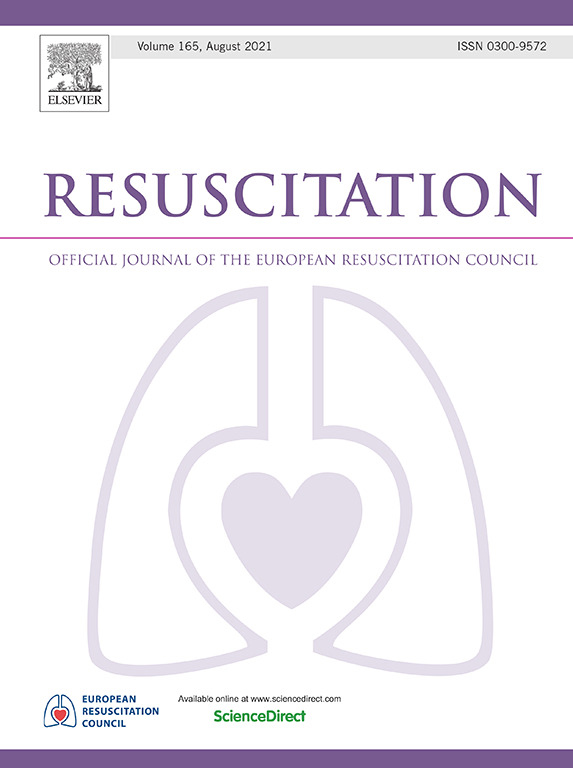智能手机激活的急救人员对提供旁观者CPR、旁观者AED和院外心脏骤停(OHCA)结果的影响。
IF 4.6
1区 医学
Q1 CRITICAL CARE MEDICINE
引用次数: 0
摘要
背景:用于激活社区第一响应者(myResponder)的智能手机应用程序于2015年在新加坡推出,用于激活院外心脏骤停(OHCA)患者的志愿第一响应者。本研究旨在探讨myResponder对提供旁观者CPR、旁观者AED和患者生存结果的影响。方法:这是一项回顾性分析,使用2016年至2019年新加坡泛亚复苏结果研究,其中包括成人非创伤性OHCA患者。患者被分为myResponder激活组和未激活组。主要结局为旁观者CPR和旁观者AED。次要终点是30天生存率,神经系统预后良好(脑功能分类1-2)。我们进行了多变量logistic回归分析,并报告了激活效应的调整优势比[aOR]和95%置信区间。结果:9167例患者纳入本分析。中位(四分位间距,IQR)年龄为71(59-82)岁。激活组包括5499例(60%)病例。与未激活组相比,激活组旁观者CPR (aOR [95%CI]: 5.69[4.89-6.62])和旁观者AED (aOR [95%CI]: 2.23[1.82-2.74])较高。激活组30天生存率更高,神经系统预后良好(aOR [95% CI]: 1.54[1.11-2.15])。结论:我们发现,在城市地区,技术激活的第一响应者的实施与旁观者CPR、旁观者AED应用和OHCA结果的改善有关。应进一步努力促进在紧急医疗服务系统中使用已激活的第一响应者。本文章由计算机程序翻译,如有差异,请以英文原文为准。
Impact of smartphone activated first responders on provision of bystander CPR, bystander AED and outcomes for out-of-hospital cardiac arrest (OHCA)
Background
The smartphone application to activate a community first responder (myResponder) was launched in 2015 to activate volunteer first responders for Out-of-Hospital Cardiac Arrest (OHCA) patients in Singapore. This study aimed to investigate the impact of myResponder on provision of bystander CPR, bystander AED, and patient survival outcomes.
Methods
This was a retrospective analysis using the Singapore Pan-Asian Resuscitation Outcomes Study between 2016 and 2019 that included adult non-traumatic OHCA patients. Patients were categorized into myResponder activated and non-activated groups. The primary outcomes were bystander CPR and bystander AED. The secondary outcome was survival at 30-days with favourable neurological outcomes (cerebral performance category 1–2). A multivariable logistic regression analysis was performed and we reported adjusted odds ratio [aOR] and 95% confidence interval for the effect of activation.
Results
9,167 patients were included in this analysis. The median (Interquartile range, IQR) age was 71 (59–82) years. The activated group comprised 5,499 (60%) of cases. The activated group was associated with higher bystander CPR (aOR [95%CI]: 5.69 [4.89–6.62]) and bystander AED (aOR [95% CI]: 2.23 [1.82–2.74]) compared to non-activated group. The activated group was associated with better survival at 30 days with favourable neurological outcomes (aOR [95% CI]: 1.54 [1.11–2.15]).
Conclusion
We found that the implementation of technology-activated first responders was associated with an improvement in the performance of bystander CPR, bystander AED application, and OHCA outcomes in an urban area. Further efforts should be made to promote the use of activated first responders in EMS systems.
求助全文
通过发布文献求助,成功后即可免费获取论文全文。
去求助
来源期刊

Resuscitation
医学-急救医学
CiteScore
12.00
自引率
18.50%
发文量
556
审稿时长
21 days
期刊介绍:
Resuscitation is a monthly international and interdisciplinary medical journal. The papers published deal with the aetiology, pathophysiology and prevention of cardiac arrest, resuscitation training, clinical resuscitation, and experimental resuscitation research, although papers relating to animal studies will be published only if they are of exceptional interest and related directly to clinical cardiopulmonary resuscitation. Papers relating to trauma are published occasionally but the majority of these concern traumatic cardiac arrest.
 求助内容:
求助内容: 应助结果提醒方式:
应助结果提醒方式:


